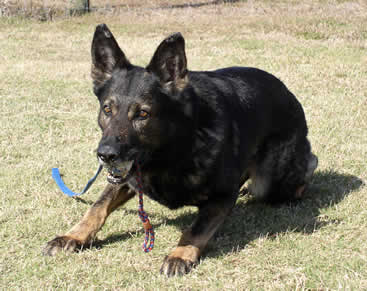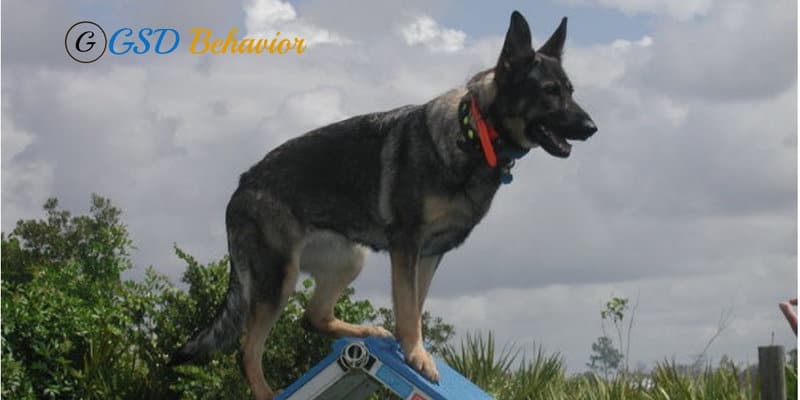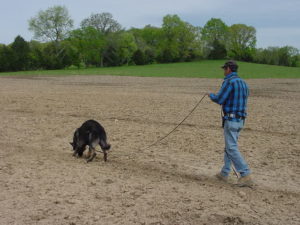Schutzhund dog training for German Shepherd breed. The GSD dog was the first breed of dog used for this sport. This dog training sport began back in the early 1900s as a temperament test for breeding.
What does the word Schutzhund mean? Protection dog in German.
Schutzhund Training for German Shepherds Explained Originating in Germany at the beginning of the century, Schutzhund is a popular activity sport for dogs and their owners. Practiced outdoors, the activity is both a physical and mental exercise. What began as a way to train police, military, herding, border patrol, and customs dogs has evolved into a sport in which anyone is welcome.
Schutzhund tests German shepherd dogs, as well as other breeds, on tracking, obedience and protection. Dogs must show absolute commitment when it comes to obedience, are asked to track footsteps over mixed terrain, and are expected to attack on command with no hesitation. Protection training is often the most misunderstood activity in the sport; dogs are not trained to attack unprovoked and must never turn on their handler.

Schutzhund competitions occur in a single day, with dog and owner participating in progressively difficult levels. Obedience, tracking, and protection skills are tested in each phase, with the ultimate dog being awarded Schutzhund III. It should be noted that only one in a thousand dogs reach this prestigious level.
The Right Age to Begin Training
Most people begin Schutzhund training when their puppy is just eight weeks old. Do puppies learn bite work this early? Typically, the answer to that question is no. What puppies do begin with is simple obedience and socialization. Keep in mind that a dog will be evaluated before it is permitted to enter any Schutzhund club; a dog with a sound mind and agreeable temperament is a must.
As a puppy develops its skills, it is introduced to rag work, scent work and attention. Adolescent dogs begin hold training, the beginnings of bite work and out of motion exercises. Schutzhund training is a progressive training. Your GSD does not simply enter the sport with no prior obedience work. If you work hard with your puppy as it ages, chances are better that you and your dog will be accepted into a Schutzhund club. If you have interest in the activity, speak with a club member. He or she will be able to give you guidance and tips for getting your puppy ready for the sport.
The Importance of Obedience Training
Consider that Schutzhund dogs are expected to obey commands without hesitation. These dogs are expected to attack when told, stop biting immediately and have the focus that enables them to track and retrieve. No dog can be expected to perform these tasks without a solid foundation of obedience work.
If you want to join a Schutzhund club with your German shepherd, obedience training should be started the first day your puppy enters your home. Teach your puppy how to focus its attention on you, sit, lie down, stay and wait on command. Your puppy should do anything that you ask of it, with extreme focus and confidence.
As you raise your puppy, you should also be sure that it is properly socialized. This means that you should take your puppy to at least one new place each week, and your puppy should meet new people and animals on a consistent basis. Schutzhund required that your dog is surrounded by other people and animals; a dog that is not well-socialized will never be able to handle this type of situation.
Once your GSD has been able to follow commands on its home turf, you should surround your puppy with distractions. Being able to follow obedience commands in your living room does not translate into following the same commands in public. Your GSD must be taught how to maintain its focus on you.
Protection Learned through Schutzhund
Protection trained dogs do not bite unprovoked. Instead, these dogs bite on command or as a means of protecting their handler. If you think that you’re going to put your GSD through Schutzhund training to turn it into a guard dog for your wife and children, think again. True protection training takes an incredible amount of work and dedication.
During protection training, GSDs are taught the escape grip, the defense grip, back transport, and the long grip. In the escape grip, the dog must hit the helper at a 45-degree angle. The dog is expected to show assertiveness and a desire to stop the decoy. In the defense grip, the dog is expected to turn from social to aggressive. Back transport involves the dog hitting the decoy’s sleeve as the decoy is running away. In the long grip, the dog is expected to hold onto the decoy’s sleeve until it is instructed to release.
The key to protection training is leveled lessons. Lessons are kept simple in order to help the dogs understand what is expected of them. Protection training should never be undertaken by an owner who does not understand the point of the training.
Schutzhund Tracking 
Schutzhund tracking is a bit different than traditional tracking. In Schutzhund, your dog is expected to keep its nose deep to the ground, following footsteps. The dog must also indicate specific articles as it walks along a footstep trail. Professional trainers suggest giving your puppy tracking lessons four days a week for four straight weeks. For pups that are doing well, a week off is in order. Tracking training should resume at week six.
Puppies are taught to find articles during the tracking process. Trainers or owners often use small pieces of leather that they wear for an hour or so as a marker. The puppy is trained to lay down, or platz, to mark its find. Clickers are helpful in training dogs to alert to articles as they are tracking. Many variables are taken into account to determine the ease or difficulty of a track. These include distance, number of articles, corner, legs, food, age, line, track layer, and environmental conditions.
Schutzhund Training Commands
Schutzhund training commands are given in the activity’s home language, German. Common commands for Schutzhund are:
– Heel or Fuss (fooos)
– Sit or Sitz (sounds like “fits”)
– Down or Platz (plotz)
– Come/Here or Hier (hee er)
– Stay or Blieb (bly’b)
– Stand or Steh (shhtay)
– Fetch or Bring (with a rolled “r”)
– Jump or Hopp (hup)
– Go Out or Voraus (for owss)
– Track or Such (tasuuk)
– Bite or Fass (pucken)
– Out/Let Go or Aus (owwss)
– No or Pfui (fooey)
– No or Nein (nine)
In parentheses above, you’ll find the way to pronounce the German words in English. For example, voraus, or go out, sounds like “for owss.” Many police organizations and the military train their K9’s using these same German commands.
